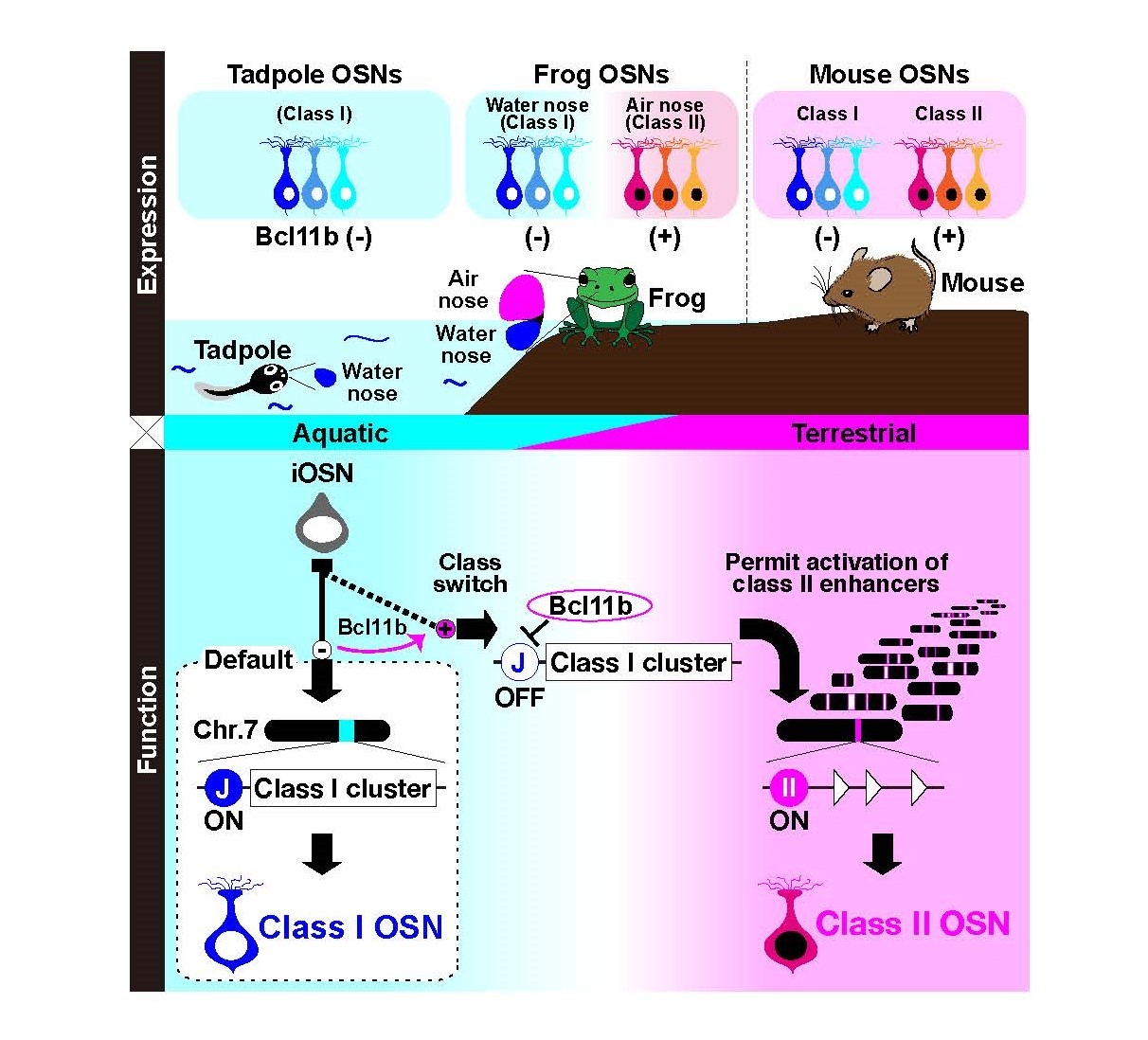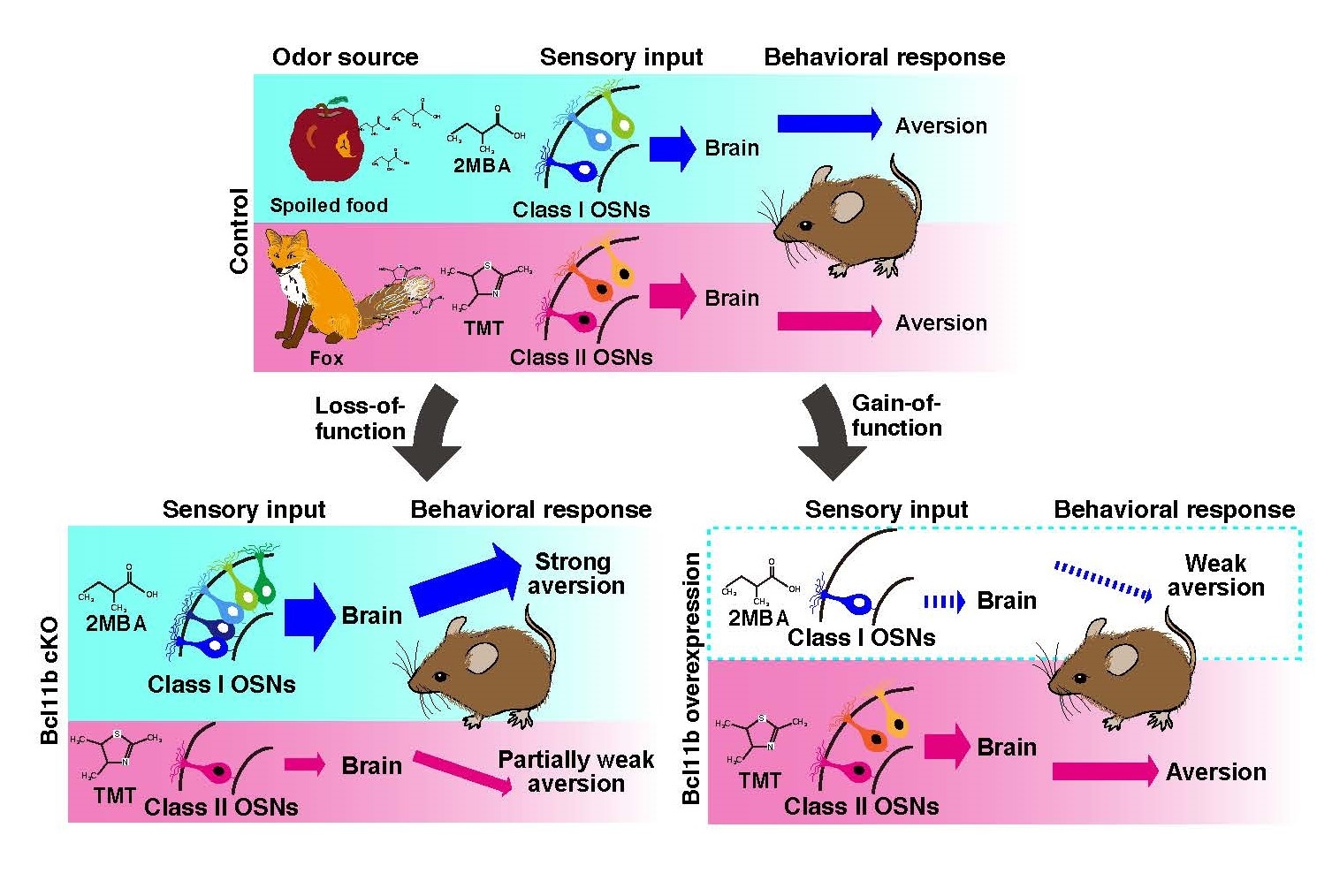Life Science and Technology News
Gene regulation behind the choice of the correct receptor for olfaction
Scientists at Tokyo Institute of Technology (Tokyo Tech) have uncovered the genetics behind two distinct types of olfactory sensory neurons; the so called "class I olfactory neurons" that has persisted from aquatic to terrestrial animals and the "class II olfactory neurons" that only terrestrial animals possess.

Have you ever wondered how marine animals smell the world, and how the olfactory system evolved from aquatic to terrestrial animals? There are two different classes of odorant receptor (OR) genes that can be expressed in olfactory sensory neurons: "class I" first identified in fish and frogs and then found to be common to all vertebrates, and "class II", which is specific to terrestrial animals. How does the olfactory sensory neuron know which class of OR to express?
"Decision between two classes of ORs is critical to both the anatomical and functional organization of olfactory system." explains Prof. Junji Hirota from the Tokyo Institute of Technology, "However, while we have known that two classes of ORs exist for more than 20 years, the mechanisms that regulate the OR class choice have remained an open question." To understand the OR selection process, he and a group of investigators set out to unveil the factors that make the decision between two classes of ORs.
The researchers discovered for the first time that Bcl11b, a transcription factor, determines which class of OR gene is expressed in olfactory neurons. In the absence of Bcl11b, olfactory neurons are fated to class I. But the fate can be switched to class II in the presence of Bcl11b. This also corroborates the idea that class I OR is the default OR, which undergoes a transcriptional switch in the presence of Bcl11b.
A similar mechanism takes place in frogs. In tadpoles, olfactory neurons express class I ORs in the so called "water-nose" until they undergo metamorphosis, when a part of their olfactory epithelium starts expressing Bcl11b, and thus start expressing class II ORs, which becomes "air-nose" in adult frogs.

Figure 1. Model of the OR class specification
Tadpoles, which express the so called "water-nose" class I genes until they undergo metamorphosis. This this point, a part of their olfactory epithelium starts expressing Bcl11b, resulting in the expression of class II, or "air-nose" genes, as well. Mice, on the other hand, expresses Bcl11b and leads to class II OR expression.
Further, the scientists demonstrated that genetically manipulating Bcl11b expression in mice not only altered the class of OR gene, but it also changed the corresponding neural wiring, altering odor perception in the animals.
By manipulating the expression of this gene in mice, the researchers generated mice with "class I-dominant" and "class II-dominant" noses. Interestingly, because these two different OR classes are linked to the entire odor perception mechanism of the animal, the mutant mice perceived aversive odors differently, i.e., "class I-dominant" mice become hyper-sensitive to decayed food odor but less sensitive to predator's odor.

Figure 2. Schematic representation of the class-specific expression of Bcl11b
Because the two different OR classes are linked to the entire odor perception mechanism of the animal, the mutant mice perceived aversive odors (i.e. the smell of predators [TMT] and spoiled food [2MBA]) differently.
"Our findings unveil a long-standing mystery in OR gene regulation, a molecular mechanism of the OR class choice as well as an essential role of Bcl11b for the functional organization of olfactory system by integrating genetic, cellular, and behavioral analyses, and provide important insights on the terrestrial adaption of olfaction during evolution," concludes Prof. Hirota.
- Reference
| Authors : | Takayuki Enomoto 1,2, Hidefumi Nishida 2, Tetsuo Iwata 1, Akito Fujita 2, Kanako Nakayama 2, Takahiro Kashiwagi 2, Yasue Hatanaka 1, Hiro Kondo 2, Rei Kajitani 2, Takehiko Itoh 2, Makoto Ohmoto 3, Ichiro Matsumoto 3 & Junji Hirota 1,2 |
|---|---|
| Title of original paper : | Bcl11b controls odorant receptor class choice in mice |
| Journal : | Communications Biology |
| DOI : | 10.1038/s42003-019-0536-x |
| Affiliations : |
1Center for Biological Resources and Informatics, Tokyo Institute of Technology, Yokohama 226-8501, Japan. 2Department of Life Science and Technology, Graduate School of Life Science and Technology, Tokyo Institute of Technology, Yokohama 226-8501, Japan. 3Monell Chemical Senses Center, Philadelphia, PA 19104, USA. |
- A pheromone-sensing gene that predates land-dwelling vertebrates | Life Science and Technology News
- A whole-body approach to understanding chemosensory cells | Life Science and Technology News
- Pioneering Discovery of an Odor-detecting Receptor Enhancer | Life Science and Technology News
- Labs spotlight #54 - Junji Hirota Laboratory - | Life Science and Technology News
- Researcher Profile | Tokyo Tech STAR Search - Junji Hirota
- Researcher Profile | Tokyo Tech STAR Search - Takayuki Enomoto
- Researcher Profile | Tokyo Tech STAR Search - Rei Kajitani
- Researcher Profile | Tokyo Tech STAR Search - Takehiko Itoh
- Department of Life Science and Technology, School of Life Science and Technology
- Latest Research News
School of Life Science and Technology
—Unravel the Complex and Diverse Phenomena of Life—
Information on School of Life Science and Technology inaugurated in April 2016
Further Information
Associate Professor Junji Hirota
Center for Biological Resources and Informatics
Email jhirota@bio.titech.ac.jp
Tel +81-45-924-5830






